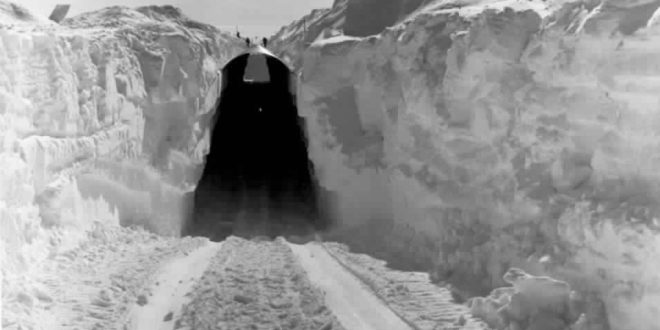Researchers have just identified what might just be the most surreal thing to emerge from the ice: the remnants of a covert U.S. Army base teeming with radioactive waste, abandoned decades ago in northwestern Greenland.
A lot of messy stuff threatens to be exposed as the ice disappears, including some 200,000 litres of diesel fuel, 240,000 litres of sewage and waste water, some toxic polychlorinated biphenyls (PCBs)—and an unknown amount of radioactive coolant, left over from the site’s nuclear generator, according to a new study, published in the journal Geophysical Research Letters.
Camp Century was built in 1959, at the height of the Cold War, beneath the surface of the northwestern Greenland ice sheet. There, the US studied deployment of nuclear missiles against Russia.
“It had up to 200 soldiers, called Iceworms, who lived in the ice,” William Colgan, a climate and glacier scientist at Toronto’s York University who is lead author on the new paper, told me. The base was positioned within the ice, not on top of it, so it wouldn’t simply be buried by the relentless snow, he explained.
After it was decommissioned in 1967, the US abandoned pretty much all of the base’s contents along with it, which wasn’t an unusual practice. “It was reasonable to expect it to snow forever,” Colgan explained, adding that Camp Century and other bases were legally established under a treaty between Denmark and the US. “The agreement had an implicit assumption: that it would keep snowing,” he said.
Given what we understand now about climate change and the Arctic, which is warming more rapidly than other parts of the world, “we have to say, these aren’t tombs for eternity. Maybe in a century, they’re going to start to melt out.”
Colgan’s climate simulations suggest that the Camp Century site could have primarily melting conditions as early as the year 2090. After that, the waste will gradually melt out, and pollutants won’t just stay in one place. They could reach the ocean, producing all kinds of disastrous consequences.
Cleaning up these sites is relatively straightforward—the US has been cleaning up its DEW Line radar bases across the Arctic, shipping hazardous waste south, as Colgan pointed out—but deciding who’s responsible, politically, quickly gets confusing.
“This isn’t just about Denmark and the US having a military treaty from 1951. Greenland is [now] self-governing, and Canada is 400 km away [from Camp Century]. It’s a multigenerational, multinational challenge presented by climate change.”
Camp Century isn’t the only hazardous dump buried under the ice. As Colgan notes, Cold War-era bases are scattered throughout the area.
“We’re moving into an era where there will be more, rather than fewer, bases in the Arctic, as it becomes more trafficked,” he told me. “The US and other NATO allies need to demonstrate good will and responsible stewardship of older base sites.”
If you were to visit Camp Century today, it would be all “flat and white,” he said, with no visible trace of what lurks under the surface. (Colgan said he last visited the site in 2010.) That won’t be the case forever. Decades ago, the military buried toxic waste in the ice, and because of climate change, it will soon be back to haunt us.
Agencies/Canadajournal
 Canada Journal – News of the World Articles and videos to bring you the biggest Canadian news stories from across the country every day
Canada Journal – News of the World Articles and videos to bring you the biggest Canadian news stories from across the country every day



